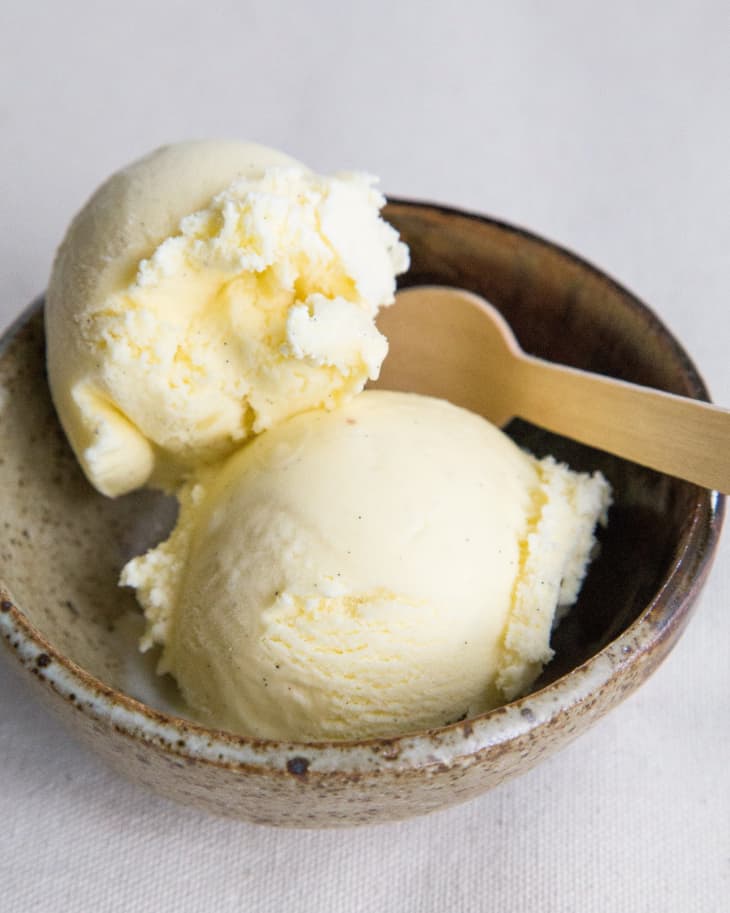What’s the Difference Between Frozen Custard and Ice Cream?
The first time I encountered frozen custard was at Shake Shack in New York City. I am a sucker for any and all frozen, creamy treats (like Popsicles and ice cream sandwiches) so when I saw custard on the menu, I was intrigued. Digging into a big cup after my burger, I was instantly in love. Extra-rich and dense, it was like the best gelato and soft serve I’d ever had joined forces. What is this magical stuff, and how does it differ from ice cream?
The Difference Between Frozen Custard and Ice Cream
Two major differences separate ice cream from frozen custard: eggs and air.
- Ice cream is made from milk, cream, or a combination of the two. An ice cream maker churns air into it to give it a light mouthfeel.
- Frozen custard is made from milk, cream, and egg yolks. It is produced in a machine that barely incorporates air into it, which means it’s more dense than ice cream.
What Is Ice Cream?
The simple answer is that ice cream is a frozen, creamy dessert made from a combination of cream, milk, and sugar. It usually has other ingredients added to alter the flavor, such as vanilla, chocolate, or strawberry, and is light in texture due to the incorporation of air through the churning process.
Ice cream can be scoop-able hard serve or soft serve, but in order for it to be called ice cream, the U.S. Food and Drug Administration (FDA) requires it to contain a minimum of 10 percent milkfat by weight. Ice cream also has more air whipped into it than custard — making ice cream airy and light, and custard velvety and dense.
A professional ice cream maker actually churns air into the ice cream base as it freezes it, which helps prevent the formation of large ice crystals. The ice cream is then usually placed in a freezer to completely firm up before it’s scooped.
Flavor combinations have changed over the years, and while grandma might have enjoyed her fair share of butter brickle, today’s ice cream flavors like birthday cake or unicorn swirl have joined their more traditional counterparts in the frozen food aisle.
According to the International Dairy Foods Association, Americans consume 22 pounds of ice cream per year. We love it so much that in 1984, then President Ronald Regan designated the month of July as National Ice Cream Month.
True Ice Cream Recipes (No Eggs!)
Ice cream and custard are often used interchangeably, so if you have an egg allergy it’s always best to double check the recipe to see if they are true ice cream recipes and not custard masquerading as ice cream. Below are our favorite egg-free ice cream recipes.
What Is Frozen Custard?
According to the FDA, frozen custard follows the same rules as ice cream but also must contain 1.4 percent egg yolks by weight. That means egg yolks are a requirement in frozen custard, which makes for a richer, more luscious product.
This can seem a little confusing because some ice creams, particularly homemade versions, contain egg yolks, too. Those would actually also be considered frozen custard by the FDA. But there is another (less technical) point that really makes frozen custard different from ice cream.
What really sets frozen custard apart from ice cream is just how dense it is. While ice cream has plenty of air whipped into it to make it light and airy, frozen custard doesn’t.
A professional custard machine works as little air as possible into the custard base, and the custard is typically served immediately from the machine at more of a soft-serve temperature, so it melts as soon as you take a bite.
Custard Recipes (Egg Yolks Aplenty!)
Most home cooks refer to frozen custard as ice cream, which is why many of our recipes at the Kitchn are also called ice cream, even though they contain egg yolks. Check out some of our favorite egg-based ice cream (aka custard) recipes.
